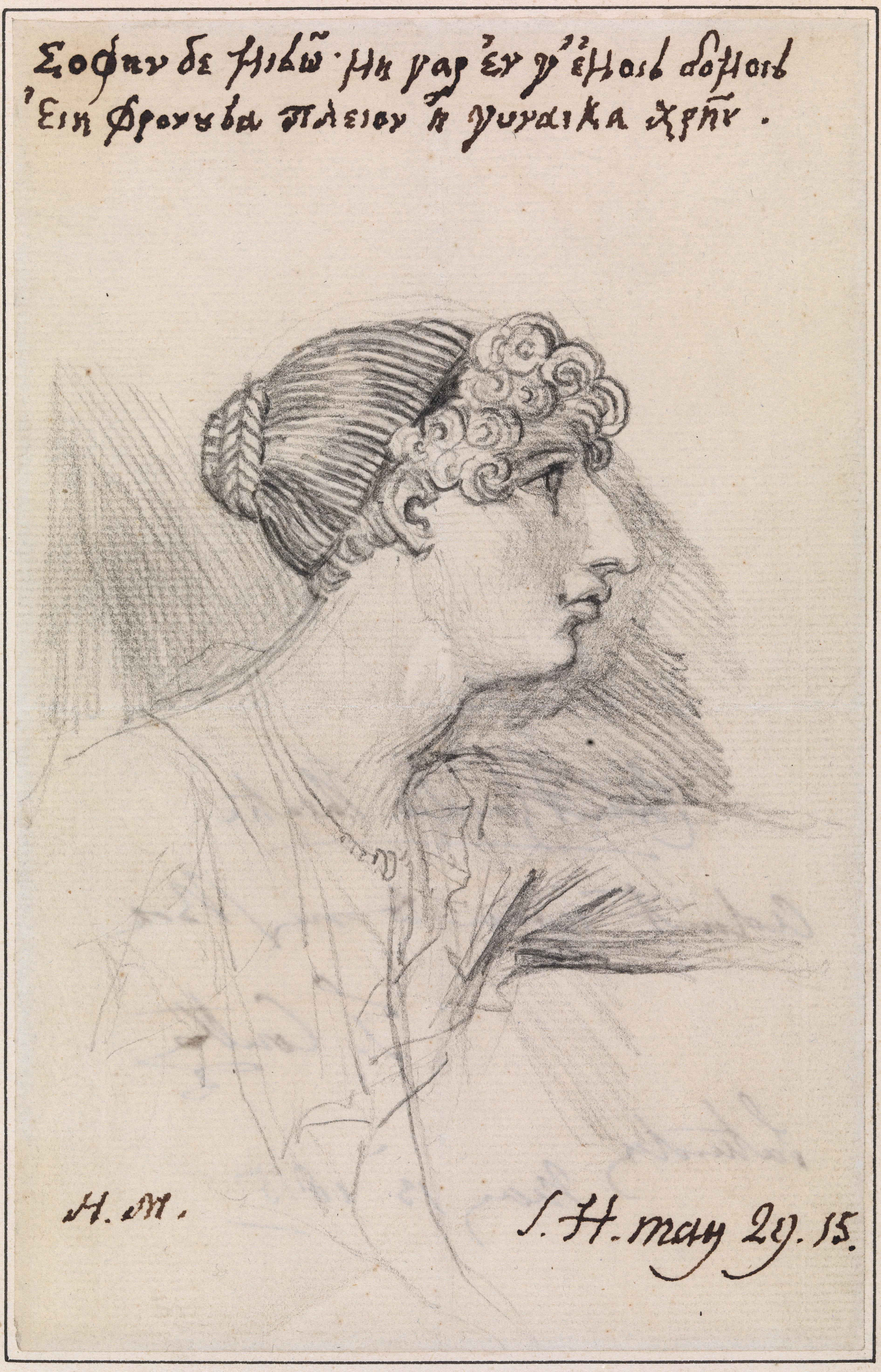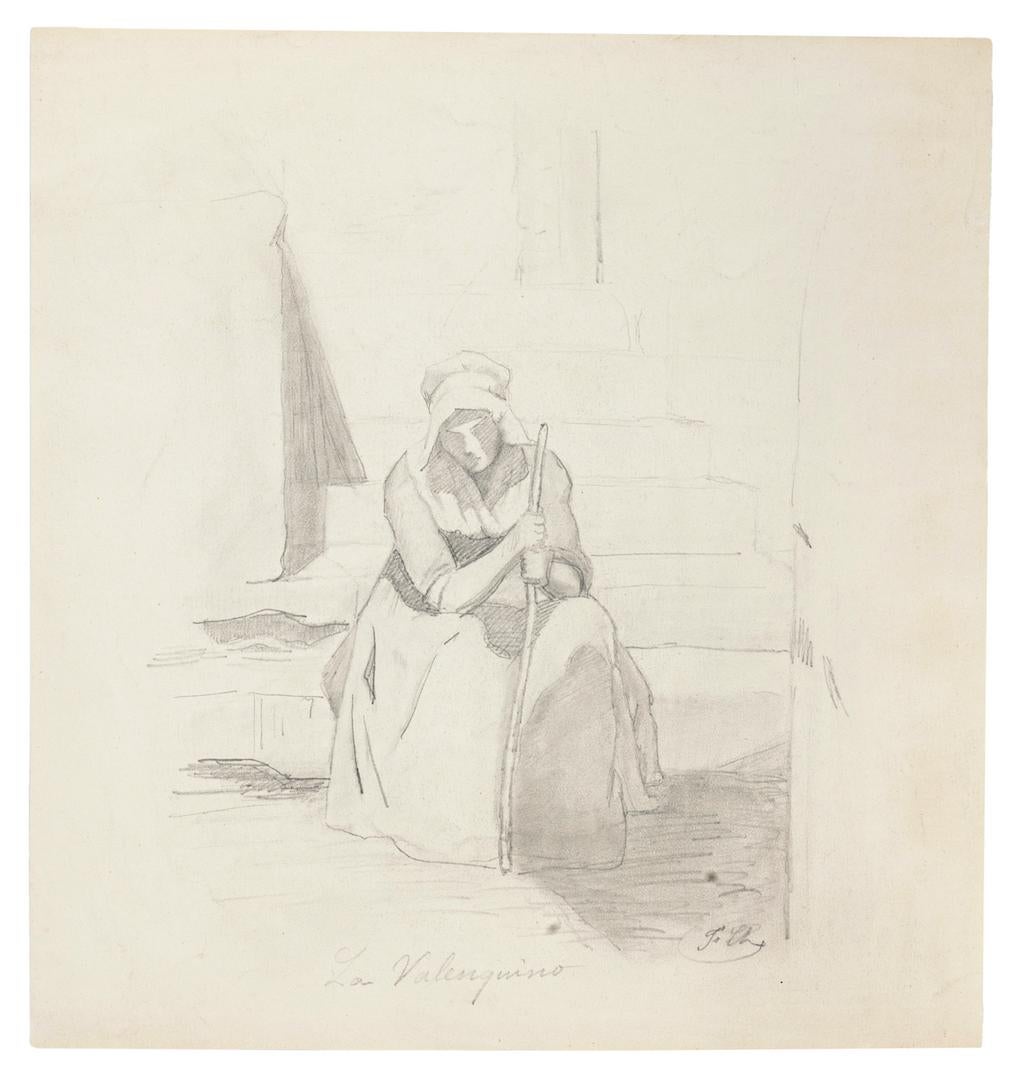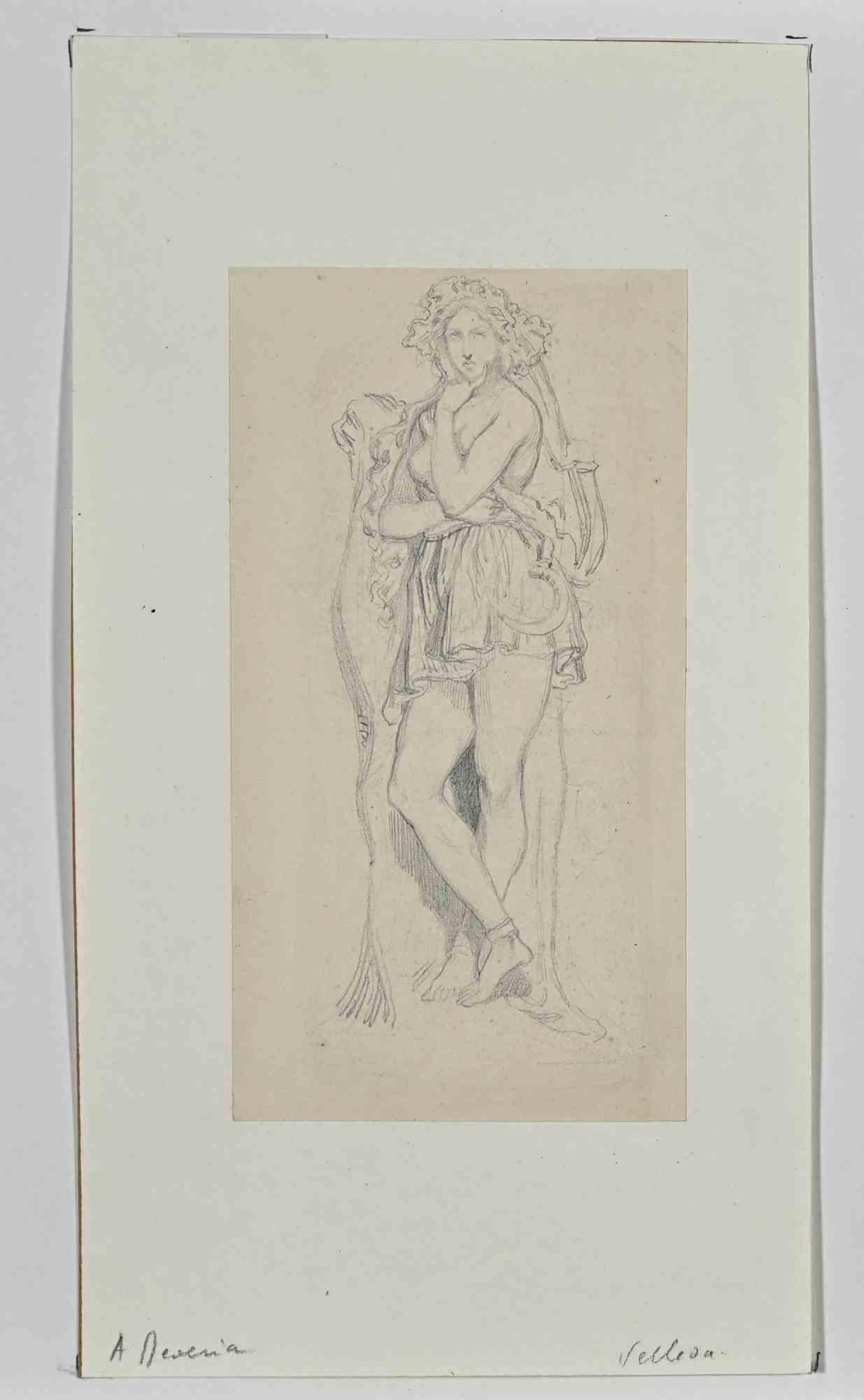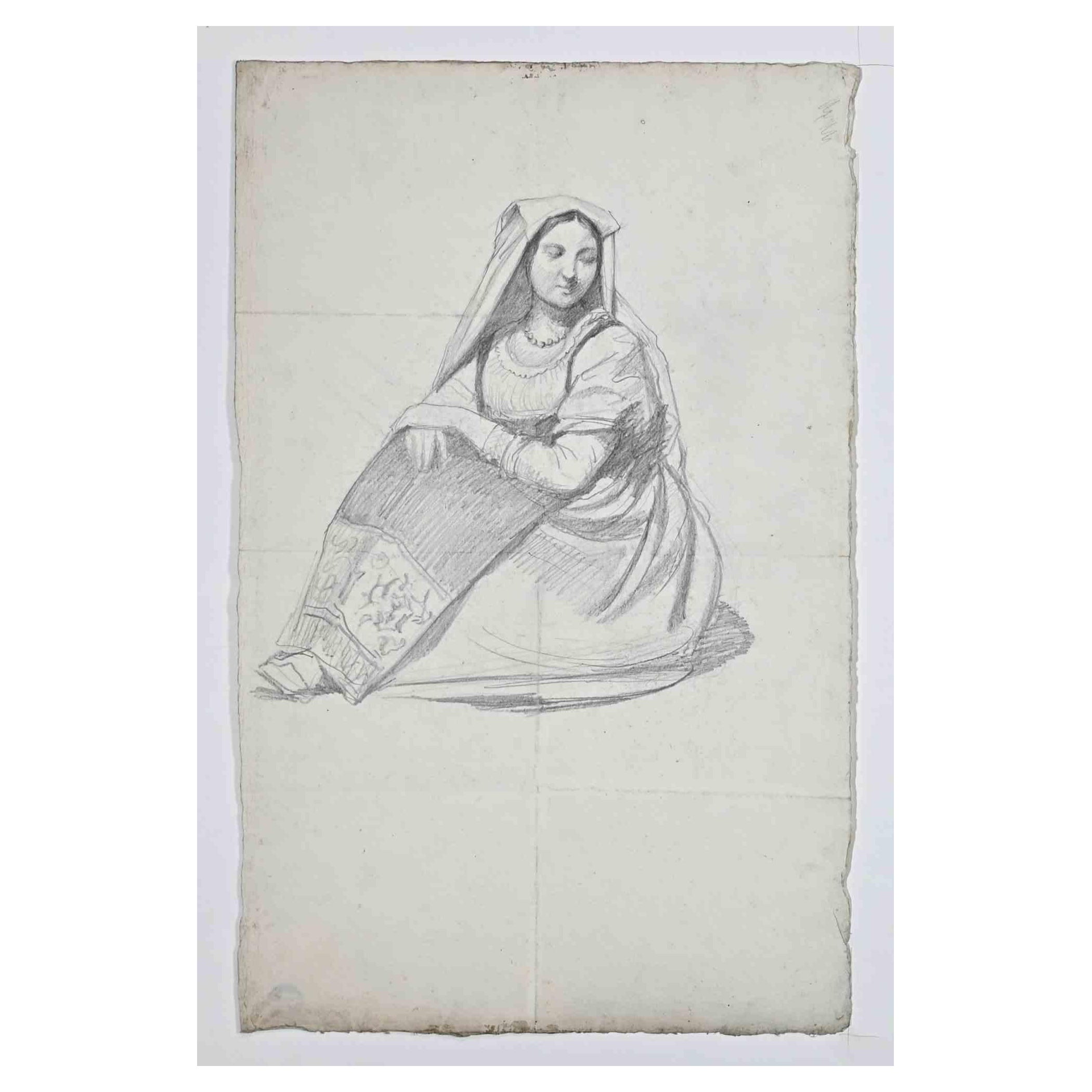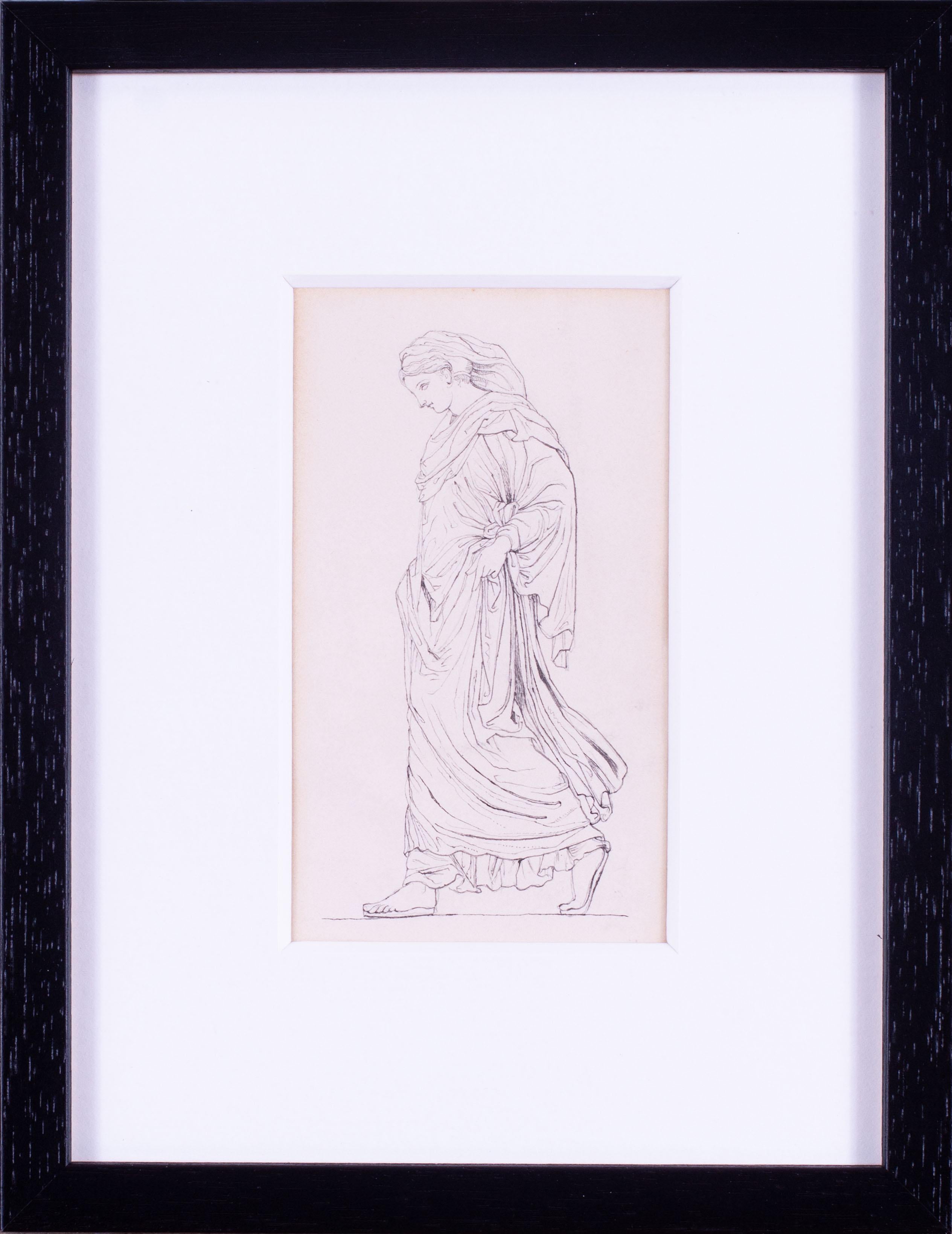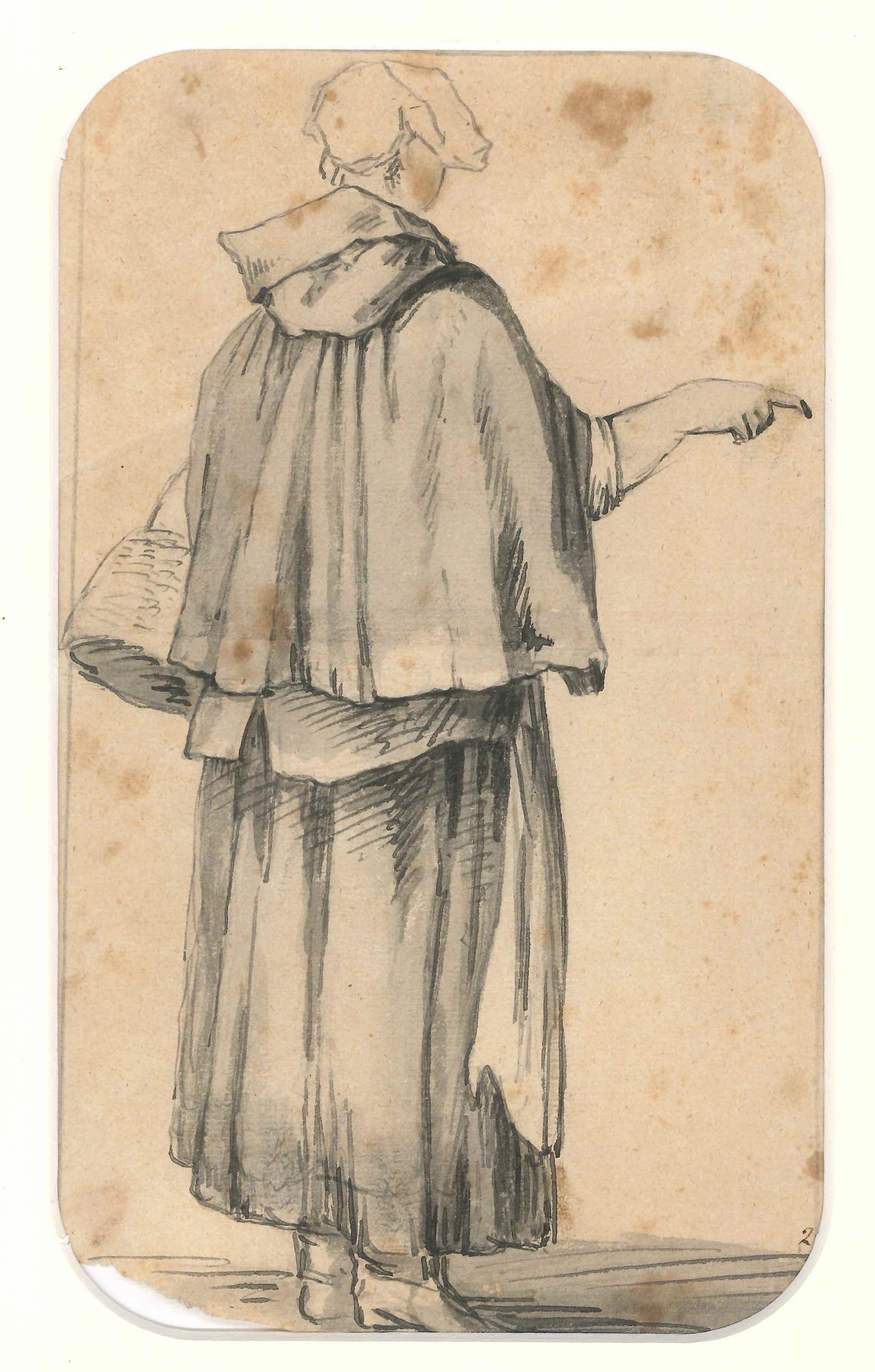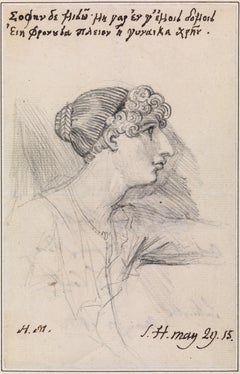Items Similar to Drawing of a captive woman
Want more images or videos?
Request additional images or videos from the seller
1 of 8
Henry FuseliDrawing of a captive womanCirca 1781
Circa 1781
$30,352.50
£22,000
€25,952.94
CA$41,749.41
A$46,407.06
CHF 24,325.59
MX$566,742.54
NOK 303,690.94
SEK 285,716.52
DKK 193,705.18
About the Item
Collections:
Sir Thomas Lawrence, who acquired the contents of Fuseli’s studio;
Susan, Countess of Guilford, née Coutts (1771-1837), acquired from the Lawrence estate;
Susan, Baroness North (1797-1884), daughter of the above;
Mrs A. M. Jaffé, acquired in France, c. 1950 to 2016.
Black chalks, on buff-coloured paper
Stamped verso: ‘Baroness Norths Collection / of Drawings by H Fuseli Esq.’
Framed dimensions: 26.38 x 20.63 inches
This boldly drawn sheet depicting a seated figure was made by Fuseli at an important and highly productive moment in his career. The monumental drawing is closely related to another sheet by Fuseli in the British Museum which Schiff published as subject unknown. Both drawings were made when Fuseli was designing his most important sequence of historical works, including scenes from Shakespeare and Milton, The Nightmare and The Death of Dido which was exhibited at the Royal Academy to great critical acclaim in 1781. The present drawing does not relate directly to any of Fuseli’s finished historical paintings of the period, but evidently the image of a slightly menacing, seated and covered old woman was precisely the sort of motif he was playing with. It is notable that the same figure reappears later in Fuseli’s work as the witch from Ben Jonson’s Witch’s Song which Fuseli produced as both a painting and engraving in 1812.
Fuseli returned to London in 1779 from a highly creative and productive period in Rome and established himself as one of the leading history painters of the period. Fuseli re-established contact with his old mentor Sir Joshua Reynolds, becoming a regular guest at his dinner table and visitor to his studio. The earliest and most striking manifestation of this strategy was Fuseli's Death of Dido, exhibited in 1781 at the Royal Academy. Executed on the same scale as Reynolds's version (Royal Collection), Fuseli's vertically oriented picture was hung directly opposite Reynolds's with its horizontal orientation, inevitably inviting comparison between the two works and garnering Fuseli much publicity and favourable reviews in the newspapers.
The present, previously unpublished sheet, relates closely to a drawing now in the British Museum. That sheet shows the same seated old woman, drawn on a smaller scale and more schematic in design, seated next to an anatomical drawing of a man. The pose of this figure is related to the pose of Dido in his Death of Dido; the foreshortened torso, arrangement of head, oblique view of Dido’s features and arms all suggest that the study can be viewed as an initial thought for the composition. Fuseli may have initially thought of including the figure of the hunched and covered old woman. Drawn on identical paper to the British Museum sheet, our study is an enlarged depiction of the same figure, more elaborately delineated and developed. The presence of a chain to the right of the figure, suggests that the iconography was related in some way to a scene of imprisonment.
Fuseli had first explored the motif of the hooded old woman in an early Roman drawing, 'The Venus Seller'. The idea of a grotesque old woman, hooded and with angular nose and projecting chin seen in profile was most spectacularly used by Fuseli in his sequence of paintings depicting The Three Witches from Macbeth. Fuseli seems to have kept the present sheet and may have returned to it when preparing a painting of The Witch and the Mandrake from Ben Jonson’s Witch’s Song from his Masque of Queens in 1812. Here the same seated figure looks out from under her hood and picks a mandrake by moonlight. Jonson’s drama had been performed at the court of James I in 1609, inspired the subject. To throw the nobility of the queens into relief, the poet added a coven of witches, one of whom declares: ‘I last night lay all alone, On the ground, to hear the mandrake groan; And plucked him up, though he grew full low, And, as I had done, the cock did crow.’ The figure was reversed in the associated etching which was published in 1812. It seems likely that the present drawing remained as part of Fuseli’s working archive of figure studies.
The present drawing was presumably purchased with the bulk of Fuseli’s drawings after the artist’s death by Sir Thomas Lawrence. Lawrence’s large group of Fuseli drawings were then acquired by Susan, Countess of Guildford (1771-1837). Lady Guildford was the eldest daughter of the banker Thomas Coutts (1735-1822), who himself had supported Fuseli’s journey to Rome in the 1770s and had remained one of the artist’s key patrons. In 1796 Susan married George, 3rd Earl of Guildford, whose father was Prime Minister of Great Britain between 1770 and 1782. She was a close friend of Fuseli and during her lifetime assembled a large and important collection of his work.
- Creator:Henry Fuseli (1741 - 1821, Swiss)
- Creation Year:Circa 1781
- Dimensions:Height: 18.13 in (46.06 cm)Width: 12.38 in (31.45 cm)
- Medium:
- Movement & Style:
- Period:
- Condition:The paper in excellent condition and the surface of the black chalk untouched. Housed in a giltwood frame.
- Gallery Location:London, GB
- Reference Number:1stDibs: LU150727721542
About the Seller
5.0
Recognized Seller
These prestigious sellers are industry leaders and represent the highest echelon for item quality and design.
1stDibs seller since 2021
5 sales on 1stDibs
- ShippingRetrieving quote...Shipping from: London, United Kingdom
- Return Policy
Authenticity Guarantee
In the unlikely event there’s an issue with an item’s authenticity, contact us within 1 year for a full refund. DetailsMoney-Back Guarantee
If your item is not as described, is damaged in transit, or does not arrive, contact us within 7 days for a full refund. Details24-Hour Cancellation
You have a 24-hour grace period in which to reconsider your purchase, with no questions asked.Vetted Professional Sellers
Our world-class sellers must adhere to strict standards for service and quality, maintaining the integrity of our listings.Price-Match Guarantee
If you find that a seller listed the same item for a lower price elsewhere, we’ll match it.Trusted Global Delivery
Our best-in-class carrier network provides specialized shipping options worldwide, including custom delivery.More From This Seller
View AllPortrait drawing of Harriot Mellon, Mrs Thomas Coutts
By Henry Fuseli
Located in London, GB
Inscribed by the artist in pen and brown ink, upper margin: 'σοφὴν δὲ μισῶ: μὴ γὰρ ἔν γ' ἐμοῖς δόμοις / εἴη φρονοῦσα πλείον' ἢ γυναῖκα χρή [Euripides, Hippolytus, 11, 640-41: “But a ...
Category
19th Century Old Masters Portrait Drawings and Watercolors
Materials
Pencil
Eighteenth century Old Master drawing - St Jerome
By John Hamilton Mortimer
Located in London, GB
Pen, ink and wash
Framed dimensions: 9 ½ x 11 ¼ inches
Drawn c. 1763
This small, powerful study shows St Jerome contemplating the bible with a cross and sk...
Category
18th Century Old Masters Figurative Drawings and Watercolors
Materials
Ink, Pen
Regency portrait drawing of Arabella Graham-Clarke
By John Downman
Located in London, GB
Collections:
The sitter, and by descent;
Christie's, 19th March 1928, lot 6;
Private collection to 2019
Literature:
G.C. Williamson, John Downman, A.R.A., his Life and Works, Lon...
Category
Early 19th Century Old Masters Portrait Drawings and Watercolors
Materials
Pencil, Watercolor
Eighteenth century Old Master drawing - Apollo destroying Niobe's children
By John Hamilton Mortimer
Located in London, GB
Pen, ink and wash
Framed dimensions: 13 x 11 ¼ inches
Drawn c.1765
Verso: a study of a hanged man
Mortimer has filled this small sheet with action, depicting in the top right, Apollo and Artemis...
Category
18th Century Old Masters Figurative Drawings and Watercolors
Materials
Ink, Pen
Regency portrait drawing of Lady Nugent
By John Downman
Located in London, GB
Collections:
With Ellis Smith, London;
Private collection, to 2015.
Literature:
G.C. Williamson, John Downman A.R.A., his Life and Works,
p. lviii no...
Category
19th Century Old Masters Portrait Drawings and Watercolors
Materials
Pencil, Watercolor
18th century ink study for the Leveson-Gower Children
By George Romney
Located in London, GB
Collections: J. Goodfriend, USA.
Brown wash and pencil on laid paper
Framed dimensions: 13.25 x 11.75 inches
This powerful drawing was made at the time that Romney was painting the famous group portrait of the Gower Children now in Abbot Hall Art Gallery, Kendal. Romney was a bold and incisive draughtsman who made numerous rich brown ink studies, principally for historical compositions; by contrast, comparatively few studies linked directly to his portraits survive. The existence of a group of studies for the Gower Children underscores its importance to Romney. The sitters were the five youngest of the eight children of Granville, 2nd Earl Gower who, at the time the portrait was commissioned, was President of the Council in Lord North’s government and one of the best-connected and most influential people in England. The present drawing which is a large scale treatment of the composition in its final form perfectly distils Romney’s conceit: the younger children dancing whilst their elder sister, in the guise of a Bacchante plays the tambourine. The bold and dramatic study underlines both the artistic confidence and classical grandeur Romney gained during his trip to Italy between 1773 and 1775.
The commission from Granville, 2nd Earl Gower to paint five of his children came shortly after Romney’s Continental tour. The initial idea, as represented by the present drawing, seems to have been to paint Lady Anne, the figure on the right of the composition playing the tambourine, who was the youngest of Gower’s first four children by his second wife Lady Louisa Egerton and who married the Rev. Edward Vernon Harcourt, later Archbishop of York, with three of her younger half-siblings by Gower’s third wife, Lady Susanna Stewart: at the left Lady Georgina, who became Countess of St Germans following her marriage to the Hon. William Eliot; at the right Lady Charlotte Sophia, later Duchess of Beaufort and in the centre Lady Susanna, later Countess of Harrowby. Romney added a fifth child to the finished portrait, Gower’s son: Lord Granville, later created Viscount Granville and Earl Granville. In Italy Romney had produced a large number of studies of classical antiquities and old master paintings.
The commission from Gower offered Romney the opportunity to explore a complex multi-figural group, putting into practice the kind of ambitious classical quotations that Reynolds was currently exploiting. In 1773 Reynolds had completed the remarkable group portrait of the Montgomery Sisters, now in the Tate Gallery, London, which showed them adorning a herm of the Roman god Hymen; the composition used a garland to link the three figures who were shown in classical costume dancing at the foot of a Roman sculpture. Scholars have long pointed to a similar sources for the two compositions: the works of Nicolas Poussin. Whilst the Montgomery Sisters is based, in part, on a Bacchanal now in the Musée des Beaux-Arts, the Gower Children has always been associated with Poussin’s Dance to the Music of Time, now in the Wallace Collection, London. It seems more likely that Romney was looking to an antique source in the form of the Borghese Dancers, a Roman relief, then in Palazzo Borghese in Rome. Romney would have seen the relief of interlocking, dancing maidens and would also have known Guido Reni’s Aurora...
Category
18th Century Old Masters Portrait Drawings and Watercolors
Materials
Ink, Pencil
You May Also Like
Tired Woman - Original Pencil Drawing - Early 20th Century
Located in Roma, IT
Tired Woman is an original drawing in pencil on paper realized by an Anonymous artist.
With the monogram of the artist's on the lower right.
The state of preservation of the artwo...
Category
Early 20th Century Modern Figurative Drawings and Watercolors
Materials
Pencil
Figure of Woman - Drawing by Achille Devéria - Early 19th century
Located in Roma, IT
Figure of Woman is a Pencil Drawing realized by Achille Deveria (1800-1857).
Good condition on a little paper included a blue cardboard passpartout (31.5x24.5 cm).
Signature on pla...
Category
Early 19th Century Modern Figurative Drawings and Watercolors
Materials
Pencil
Woman - Original Pencil Drawing by Raymond Balze - Mid 19th century
Located in Roma, IT
Woman is an Original Pencil Drawing realized by Raymond Balze (1818-1909).
Good Condition on a yellowed paper included a white cardboard passpartout (67x51 cm).
No signature.
Raym...
Category
Mid-19th Century Modern Figurative Drawings and Watercolors
Materials
Pencil
19th Century drawing attributed to John Flaxman of a classical maiden
By John Flaxman
Located in Petworth, West Sussex
Attributed to John Flaxman (British, 1755- 1826)
Study of a classical maiden
Pen and ink on paper
5.1/2 x 3.1/8 in. (14 x 8 cm.)
Category
19th Century Academic Figurative Drawings and Watercolors
Materials
Paper, Ink, Pen
Figure of Breton Woman - Drawing by J. P. Verdussen - End of 18th Century
By Jan Pieter Verdussen
Located in Roma, IT
Figure of Breton Woman is a beautiful ink and watercolor original drawing on wire rod and watermarked paper realized at the middle of XVIII century by Jan Peter Verdussen.
This ori...
Category
Early 18th Century Old Masters Figurative Drawings and Watercolors
Materials
Paper
La Femme Muse /// Allegorical Symbolism Romantic Old Masters European Drawing
Located in Saint Augustine, FL
Artist: Unknown (Likely French, 18th Century)
Title: "La Femme Muse"
*No signature found
Circa: 1780
Medium: Original Pastel Drawing on heavy laid paper
Frami...
Category
1780s Old Masters Figurative Drawings and Watercolors
Materials
Pastel, Laid Paper
$1,200 Sale Price
78% Off
More Ways To Browse
Old Woman
Large Scale Drawing
Paintings Of Older Woman
Old Master Drawings Framed
James A Rome
M Henry Painting
Painting Of Laying Woman
Countess Painting
Witch Painting
Woman Posing Seated
Susan George
Ben Thomas
Reynolds Joshua
Roman Torso
Lady Figure Table
Antique Lay Figure
Reynolds Etching
Antique Anatomical Drawings
